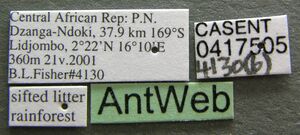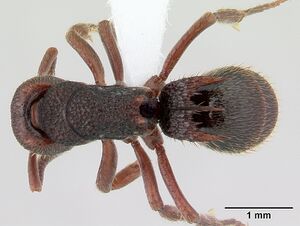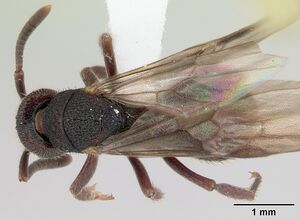Phrynoponera bequaerti
| Phrynoponera bequaerti | |
|---|---|

| |
| Scientific classification | |
| Kingdom: | Animalia |
| Phylum: | Arthropoda |
| Class: | Insecta |
| Order: | Hymenoptera |
| Family: | Formicidae |
| Subfamily: | Ponerinae |
| Tribe: | Ponerini |
| Genus: | Phrynoponera |
| Species: | P. bequaerti |
| Binomial name | |
| Phrynoponera bequaerti Wheeler, W.M., 1922 | |
The vast majority of the material examined was extracted from leaf litter samples, though occasional samples from rotten wood have been recorded. Unlike Phrynoponera gabonensis and Phrynoponera sveni, bequaerti has not been found in termitaries. (Bolton and Fisher 2008)
Identification
Almost as common and widespread as Phrynoponera gabonensis and by far the smallest species in the genus, bequaerti is easily recognised by its size, lack of clypeal teeth and short, broad funicular segments. (Bolton and Fisher 2008)
Keys including this Species
Distribution
Ghana, Cameroun, Gabon, Central African Republic and Democratic Republic of Congo.
Latitudinal Distribution Pattern
Latitudinal Range: 6.417222222° to -2.283333333°.
| North Temperate |
North Subtropical |
Tropical | South Subtropical |
South Temperate |
- Source: AntMaps
Distribution based on Regional Taxon Lists
Afrotropical Region: Cameroon, Central African Republic, Democratic Republic of Congo (type locality).
Distribution based on AntMaps
Distribution based on AntWeb specimens
Check data from AntWeb
Countries Occupied
| Number of countries occupied by this species based on AntWiki Regional Taxon Lists. In general, fewer countries occupied indicates a narrower range, while more countries indicates a more widespread species. |

|
Estimated Abundance
| Relative abundance based on number of AntMaps records per species (this species within the purple bar). Fewer records (to the left) indicates a less abundant/encountered species while more records (to the right) indicates more abundant/encountered species. |

|
Biology
Castes
Worker
Images from AntWeb
   
| |
| Worker. Specimen code casent0411279. Photographer April Nobile, uploaded by California Academy of Sciences. | Owned by CAS, San Francisco, CA, USA. |
   
| |
| Worker. Specimen code casent0417505. Photographer April Nobile, uploaded by California Academy of Sciences. | Owned by CAS, San Francisco, CA, USA. |
   
| |
| Worker. Specimen code casent0417506. Photographer April Nobile, uploaded by California Academy of Sciences. | Owned by CAS, San Francisco, CA, USA. |
   
| |
| Worker. Specimen code casent0417524. Photographer April Nobile, uploaded by California Academy of Sciences. | Owned by CAS, San Francisco, CA, USA. |
     
| |
| Worker. Specimen code casent0411278. Photographer April Nobile, uploaded by California Academy of Sciences. | Owned by CAS, San Francisco, CA, USA. |
Queen
Images from AntWeb
   
| |
| Queen (alate/dealate). Specimen code casent0178231. Photographer April Nobile, uploaded by California Academy of Sciences. | Owned by CAS, San Francisco, CA, USA. |
   
| |
| Queen (alate/dealate). Specimen code casent0417548. Photographer April Nobile, uploaded by California Academy of Sciences. | Owned by CAS, San Francisco, CA, USA. |
Nomenclature
The following information is derived from Barry Bolton's Online Catalogue of the Ants of the World.
- bequaerti. Phrynoponera bequaerti Wheeler, W.M. 1922a: 79, fig. 12 (q.) DEMOCRATIC REPUBLIC OF CONGO. Bolton & Fisher, 2008b: 41 (w.).
Unless otherwise noted the text for the remainder of this section is reported from the publication that includes the original description.
Description
Worker
Bolton and Fisher (2008) - (previously undescribed). TL 5.0-5.7, HL 1.16-1.25, HW, 1.13-1.23, CI 96-101, SL 0.90-0.97, SI 75-81, PW 0.90-1.02, WL 1.66-1.90, maximum diameter of eye 0.28-0.32, OI 24–27 (20 measured).
Mandible smooth with scattered pits, usually with 4 teeth but very rarely with 3 or 5. Median portion of clypeus with anterior margin transverse to very shallowly concave, without a tooth-like cuticular prominence on each side. Cephalic dorsum finely and densely reticulate-rugose, the bases of the reticulae punctate. Funicular segments 2-7 distinctly broader than long. Dorsum of mesosoma reticulate-rugose. Petiolar spines curve far back over the first gastral tergite; median spine at least three-quarters the length of the outer pair; intermediate spines much shorter and usually much more slender, often reduced and needle-like by comparison with the others. Gastral tergites 1-2 longitudinally costulae upon a reticulate-punctate ground sculpture; often with some anastomoses between the costulae. Colour varies considerably. In darkest forms the head and body are almost entirely black, with only the mandibles and legs reddish brown to red. From this there is a gradual increase in the amount of blackish red to dull red on most areas of the body until in the lightest colour forms the entire head is reddish, the legs are red and even the mesosoma, petiole and parts of the gaster are suffused with red.
Type Material
Bolton and Fisher (2008) - Holotype queen, DEMOCRATIC REPUBLIC OF CONGO: N’Gayu (= Ngayu), stomach Bufo superciliaris (H.O. Lang) (American Museum of Natural History) [examined].
References
- Bolton, B. and B. L. Fisher. 2008. The Afrotropical ponerine ant genus Phrynoponera Wheeler. Zootaxa. 1892:35-52. *PDF
- Wheeler, W. M. 1922b. Ants of the American Museum Congo expedition. A contribution to the myrmecology of Africa. II. The ants collected by the American Museum Congo Expedition. Bull. Am. Mus. Nat. Hist. 45: 39-269 (page 79, fig. 12 queen described)
References based on Global Ant Biodiversity Informatics
- Belshaw R., and B. Bolton. 1994. A survey of the leaf litter ant fauna in Ghana, West Africa (Hymenoptera: Formicidae). Journal of Hymenoptera Research 3: 5-16.
- Belshaw R., and B. Bolton. 1994. A survey of the leaf litter ant fauna in Ghana, West Africa (Hymenoptera: Formicidae). Journal of Hymenoptera Research. 3: 5-16.
- Bolton B., and B. L. Fisher. 2008. The Afrotropical ponerine ant genus Phrynoponera Wheeler (Hymenoptera: Formicidae). Zootaxa 1892: 35-52.
- Bolton, B. and B.L. Fisher. 2008. Afrotropical ants of the ponerine genera Centromyrmex Mayr, Promyopias Santschi gen. rev. and Feroponera gen. n., with a revised key to genera of African Ponerinae (Hymenoptera: Formicidae). Zootaxa 1929:1-37.
- Braet Y., and B. Taylor. 2008. Mission entomologique au Parc National de Pongara (Gabon). Bilan des Formicidae (Hymenoptera) recoltes. Bulletin S. R. B. E./K.B.V.E. 144: 157-169.
- Fisher B. L. 2004. Diversity patterns of ants (Hymenoptera: Formicidae) along an elevational gradient on Monts Doudou in southwestern Gabon. Memoirs of the California Academy of Sciences 28: 269-286.
- IZIKO South Africa Museum Collection
- Yeo K., and A. Hormenyo. 2007. A Rapid Survey of Ants in Ajenjua Bepo and Mamang River Forest Reserves, Eastern Region of Ghana. Pp 27-29. In McCullough, J., P. Hoke, P. Naskrecki, and Y. Osei-Owusu (eds.). 2008. A Rapid Biological Assessment of the Ajenjua Bepo and Mamang River Forest Reserves, Ghana. RAP Bulletin of Biological Assessment 50. Conservation International, Arlington, VA, USA.

